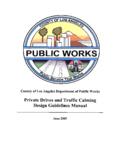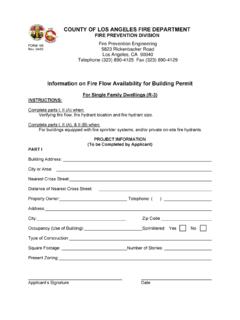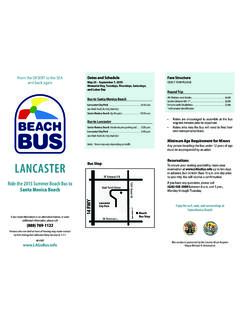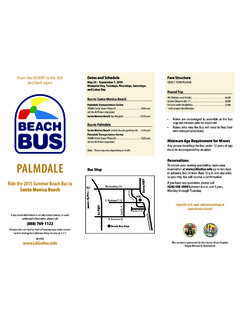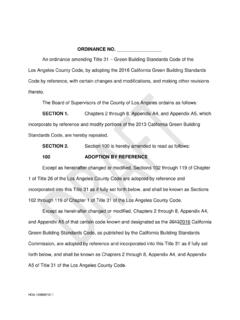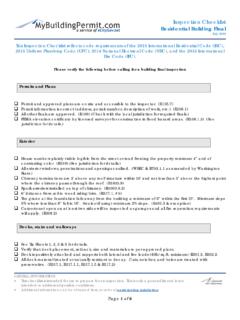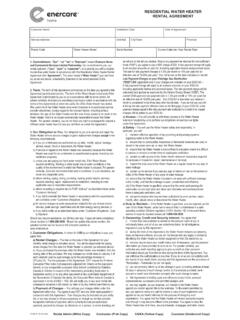Transcription of DESIGN OF RETAINING WALLS
1 residential CODE MANUAL #1014. COUNTY OF LOS ANGELES DEPARTMENT OF PUBLIC WORKS Article 1. BUILDING AND SAFETY DIVISION 10-25-12. Based on the 2011 LACRC Page 1 of 7. DESIGN OF RETAINING WALLS . ISSUE: residential Code Section specifies that RETAINING WALLS shall be designed to ensure stability against overturning, sliding, excessive foundation pressure and water uplift In addition, Section states that the building official may require plans and specifications to be prepared and designed by an engineer licensed or registered by the state to practice as such.
2 Therefore, any RETAINING wall DESIGN requiring a building permit shall be performed by a registered DESIGN professional. As an option, the professional may elect to DESIGN such wall under similar provisions of BCM Article 1 as followed: Building Code Section requires RETAINING WALLS to be designed to ensure stability against overturning, sliding, excessive foundation pressure and water uplift and Section requires foundation WALLS to be designed in accordance with Chapter 19 (Concrete) and/or 21 (Masonry). In addition, Section states that RETAINING WALLS shall include lateral pressures due to earthquake motions in Seismic DESIGN Categories D through F.
3 Such WALLS shall be designed for a safety factor of against lateral sliding and overturning, but where earthquake loads are included, the minimum safety factor of RETAINING wall sliding and overturning shall be pursuant to Section Section requires foundation (basement) and RETAINING WALLS to be designed to resist the soil lateral loads specified in Table , unless otherwise specified by a soils investigation report. POLICY: As stated in Section of the 2012 International Building Code (IBC) Commentary, because the requirement can be onerous for small structures and RETAINING WALLS , the applicability is limited to those WALLS that are higher than 6 feet.
4 The County of Los Angeles is adopting the provision of this Section: Seismic DESIGN Categories D through F. For structures assigned to Seismic DESIGN Category D, E or F, the geotechnical investigation required by Section shall also include all of the following as applicable: 1. The determination of dynamic seismic lateral earth pressures on foundation WALLS and RETAINING WALLS supporting more than 6 feet ( m) of backfill height due to DESIGN earthquake ground motions . Due to the variability in soil properties throughout the County of Los Angeles, the DESIGN professional must take care in his or her analysis of basement and site RETAINING WALLS .
5 Without the substantiation of a soils investigation to recommend otherwise, the following Tables shall be used to determine the equivalent fluid pressure for DESIGN of basement and RETAINING WALLS in place of Table 1610. #1014 Article 1 residential CODE MANUAL Page 2 of 7. The use of such at-rest pressure from Table of Equivalent Fluid Weights For Active Pressure And At-Rest Pressure Based on Expansive Soil Condition for basement wall designs shall be limited to only basement WALLS that serve as site WALLS and are not structural elements of habitable structures.
6 Site WALLS may be structural elements of decks, carports, patios, storage buildings, etc. in which these structures are non-habitable and support only their roofs. Case 1 - DESIGN of RETAINING Wall (Hretaining 6 ft): Active pressure shall be distributed vertically based on triangular loading and at-rest pressure shall be distributed based on rectangular loading. Note that Table of Equivalent Fluid Weights For Active Pressure And At-Rest Pressure Based on Expansive Soil Condition values are minimum lateral loads and do not account for any surcharge and seismic lateral earth pressures other than the slope as shown.
7 The DESIGN professional is responsible for complete analysis in accordance with Section 1807 for RETAINING WALLS and site WALLS supporting a maximum of 6 ft high backfill as measured from the top of the footing. H H. Active At-Rest Pressure Pressure TABLE OF EQUIVALENT FLUID WEIGHTS FOR ACTIVE PRESSURE AND AT-REST. PRESSURE BASED ON EXPANSIVE SOIL CONDITION. Restrained equivalent Cantilever equivalent Fluid weight Surface slope of Fluid weight (at-rest pressure). Retained material (active pressure) For WALLS supporting 6' max Horizontal to vertical*.
8 (pcf) backfill with a rigid diaphragm** (pcf). LEVEL 45 60. 5 to 1 49 64. 4 to 1 53 68. 3 to 1 57 72. 2 to 1 61 76. * If the retained earth has a surface slope that varies, then the DESIGN surface slope shall be based on an imaginary line starting from the top of the RETAINING wall to the highest point of the slope. ** Top of wall shall be restrained by rigid diaphragm. Rigid diaphragm shall be a structural slab or equivalent with capacity to resist deflection of the top of the wall. Exception: Basement WALLS may be designed using active pressure, provided the basement wall is 6-feet or less in height and is supported by a flexible floor system.
9 #1014 Article 1 residential CODE MANUAL Page 3 of 7. Case 2 - DESIGN of RETAINING Wall (6 ft < Hretaining 12 ft): Where the backfill is greater than 6 feet, but less than or equal to 12 feet in height, such proposed WALLS shall be designed with an active pressure vertically distributed based on triangular loading and an additional seismic lateral pressure vertically distributed based on an inverted triangular loading per the values of Table of Equivalent Fluid Weights For Active Pressure Based on Non- Expansive Soil Condition (see below).
10 ( WALLS designed with an at-rest pressure shall submit a geotechnical report that includes seismic lateral forces.) Note that these Table values are minimum lateral loads and do not account for any surcharge other than the slope as shown. The prescriptive RETAINING wall DESIGN with active and seismic pressures shall be compared with a RETAINING wall DESIGN of equivalent height using only active pressure from Table of Equivalent Fluid Weights For Active And At-Rest Pressure Based on Expansive Soil Condition (see above).



